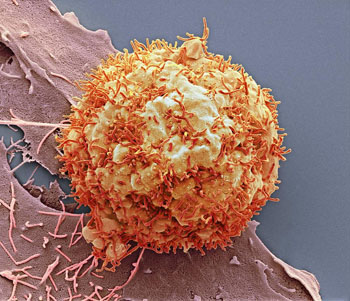Novel Treatment Uses Bacteria Engineered to Delivery Pulses of Anti-Cancer Drugs
By LabMedica International staff writers
Posted on 01 Aug 2016
A novel method for treating liver tumors is based on genetically engineered bacteria that respond to population pressure by lysing and releasing pulses of anti-cancer drugs.Posted on 01 Aug 2016
Some bacteria have evolved to preferentially grow in environments that harbor disease, such as the oxygen-depleted tumor microenvironment, and thus provide an attractive platform for the development of engineered therapies. Such therapies could benefit from bacteria that were programmed to limit bacterial growth while continually producing and releasing cytotoxic agents.

Image: A scanning electron micrograph (SEM) of a liver cancer cell (Photo courtesy of SPL).
In pursuing this concept, investigators at the Massachusetts Institute of Technology (Cambridge, MA, USA) and collaborators at the University of California, San Diego, (USA) engineered a clinically relevant bacterial "circuit" that would lyse synchronously at a threshold population density and release genetically encoded cargo. Following quorum lysis, a small number of surviving bacteria initiated a newly growing population, thus leading to waves of delivery cycles.
The investigators used microfluidic devices to characterize the engineered lysis strain, and they demonstrated its potential as a drug delivery platform via co-culture with human cancer cells in vitro. As a proof of principle, they tracked the bacterial population dynamics in colorectal tumors in mice via a luminescent reporter protein.
In a separate experiment, the investigators orally administered the lysis strain alone or in combination with a clinical chemotherapeutic agent to a syngeneic mouse transplantation model of colorectal cancer that had spread to the liver. They reported in the July 20, 2016, online edition of the journal Nature that the combination of both engineered bacteria and chemotherapy led to a notable reduction of tumor activity along with a marked survival benefit over either therapy alone. Engineered bacteria that escaped from the liver were effectively cleared by the immune system, which helped to minimize potential side effects.
“Tumors can be friendly environments for bacteria to grow, and we are taking advantage of that,” said contributing author Dr. Sangeeta Bhatia, professor of health sciences, electrical engineering, and computer science at the Massachusetts Institute of Technology.
Related Links:
Massachusetts Institute of Technology
University of California, San Diego




 assay.jpg)




 Analyzer.jpg)




